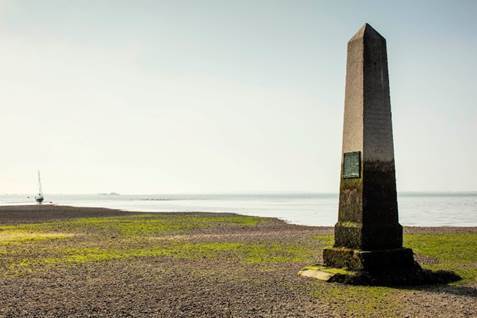The Crow Stone, Chalkwell Beach, Southend has been listed at Grade II by the Department for Digital, Culture, Media and Sport (DCMS) on the advice of Historic England.
Five other seaside heritage sites across the country have also been listed, including a picturesque boathouse off the coast of Devon that was built to celebrate the coronation of King George IV in 1937, eight of Blackpool’s iconic promenade shelters and a former convalescent home in Skegness.
England has a rich and distinctive seaside heritage. Ranging from piers to pavilions, bathing pools to beach huts, there are so many colourful historic sites that reflect almost 300 years of seaside holidays and are still welcoming millions of visitors each year.
Seaside resorts began as a relaxing place for the wealthy few to promenade and look out to sea, as well as recover from illness. Later, destinations like Blackpool were the place for working class people to holiday and unwind. This summer our seaside resorts are enjoying an influx of visitors again and these six newly listed sites offer a small insight into the range of seaside heritage England has to celebrate.
About the Crow Stone, Chalkwell Beach, Southend – listed at Grade II
The Crow Stone is an eight-metre-tall stone obelisk that sits proudly on Chalkwell Beach in Southend. It was erected between 1836 and 1837 to mark the eastern boundary of the City of London’s control over the River Thames. The City purchased the rights of control from King Richard I in 1197 and took charge of the fisheries and tolls along both the Thames and part of the River Medway.
The City of London’s territory was marked by London Stones, such as the stone at Upnor (listed at Grade II) and at Yantlet Creek (also listed at Grade II). The Lord Mayor of London and other officials would visit them on their septennial river trips, with all their associated pomp and circumstance.
Although the City lost its control of the river to the Crown in 1857, the presence of the London Stones is a reminder of the historical events that took place, as well as the City of London’s determination to retain power and influence.
This obelisk replaced a previous stone from 1755 and was designed to be sturdier and more visible than previous versions. Still standing nearly 200 years later despite tidal waters, it has certainly met its target.
Deborah Mays, Head of Listing at Historic England, said: ‘Our seaside towns are a huge part of our national story. People have enjoyed trips and holidays to our coastal towns for hundreds of years and each place contributes to an important part of our shared history. I’m thrilled the significance of our seaside heritage has been recognised with these six new listings, especially as so many of us will be heading to the seaside to enjoy the final few days of summer this bank holiday weekend.”




